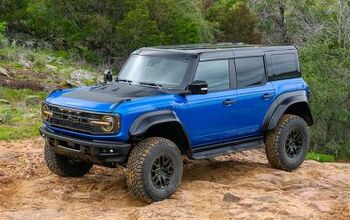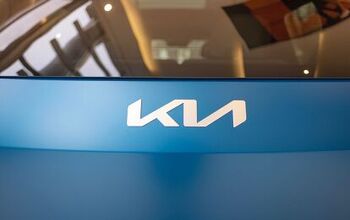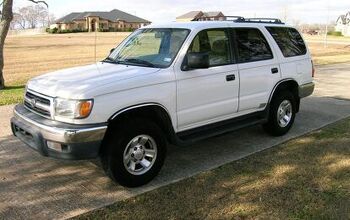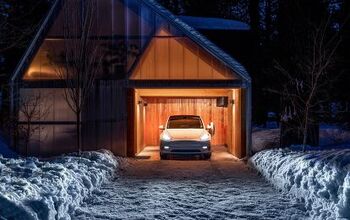Head of the Class 8? With Its Semi, Tesla Promises a Trucking Alternative

Even though a next-generation Tesla Roadster unexpectedly rolled out of the back of one, it was still beyond weird to see the world’s automotive press converging on a California warehouse for the reveal of a big rig on Thursday night. But this is the scene we’ve grown accustomed to when something occurs in the Tesla universe.
The delayed reveal of the automaker’s electric semi truck, which surely has the Tesla fan base downloading C.W. McCall’s Convoy on Spotify this morning, is a proposition to trucking companies. Buy this Class 8 transport and save.
The Semi’s specifications are straightforward, even if the economics surrounding the vehicle are not. For a currently undisclosed price, Tesla plans to sell a day cab semi-trailer with a gross vehicle weight rating of 80,000 pounds, with power provided by four Model 3 motors.
Up front, a center-seated driver cocooned in carbon fiber panels monitors the vehicle (and the blind spots) through two display screens mounted to his or her left and right. An Enhanced Autopilot system would handle lane-keeping duties and apply the brakes if needed. From this perch, a driver can pilot the truck for 300 or 500 miles, depending on variant, then dump 400 miles into the massive under-cab battery pack via a 30-minute charge courtesy of the currently hypothetical Megacharger network.
According to the American Transportation Research Institute, 62 percent of U.S. pickups and deliveries fall within the longer-ranged model’s range.
Wowing the assembled journos and Teslarati, company CEO Elon Musk touted the truck’s scorching acceleration times — hardly top of mind for fleet operators, but this is Tesla, after all. The company claims a 0-60 mph time of five seconds for an unburdened rig, or 20 seconds hauling a trailer bursting at the seams. On a 5-percent grade, Tesla says the Semi can maintain 65 mph.
Speed is nice, but cost is key for any operator. And unpacking the Semi’s economics proved difficult. The operational cost figure tossed out by Tesla is $1.26 per mile, with rival diesel models pegged at $1.51. Chalk up the difference to reduced fuel costs (Tesla claims a $200,000 fuel savings over the life of the vehicle, which is guaranteed for 1 million miles), plus reduced maintenance. As the model employs regenerative braking, Musk touted the Semi’s brake pads as having a “quasi-infinite lifespan.”
TTAC’s own Bozi Tatarevic takes issue with Tesla’s math, claiming that maintenance costs would need to fall nearly to nearly zero in order to reach the stated operational costs. Of course, the model’s mysterious price doesn’t help the calculations.
“Average maintenance cost for diesel trucks is around $0.166 now and considering how Tesla runs parts and service, I am hard pressed to believe that they can reduce that to $0.03 or so,” Tatarevic said in a Twitter post (one of many that raised the ire of the Tesla fan base).
So, are you interested? If so, be prepared to wait until 2019 for production to begin, but the company will take your $5,000 reservation now. According to the terms and conditions of those reservations, “the timing of your order may depend on development, manufacturing and production schedules, among other factors.”
Given that the company’s main focus right now is clearing assembly and supply hurdles for the Model 3 sedan — which recently saw its production ramp-up pushed back by a quarter of a year — you might not want to set that calendar date in stone. No one knows where Tesla plans to build the thing, as its Fremont assembly plant won’t have the spare capacity after the company reaches its passenger car production goals. The company’s currently burning through all available cash to iron out issues delaying the ramp-up. (Maybe that’s where the $250,000 upfront price for the first 1,000 Roadsters comes in.)
As well, the Megacharger network exists only on paper. How the company plans to juggle all of these balls (and pay for them) at the same time remains a nagging question. Still, it won’t be a shock to see the automaker’s stock soar once trading opens this morning. That’s just how it goes in Teslaland.
[Images: Tesla]

More by Steph Willems
Latest Car Reviews
Read moreLatest Product Reviews
Read moreRecent Comments
- ToolGuy No hybrid? No EV? What year is this? lolI kid -- of course there is an electric version.
- Tassos No, this is for sure NOT my favorite Caddy. Very few Caddys with big fins work out as designs.FOr interiors, I much prefer the Caddys and other US luxury cars from the 30s, Packards etc. After the war, they ditched the generous wood veneer (without which no proper luxury car) for either nothing or the worse than nothing fake wood.For exterior, I like many Caddys from the 60s and early 70s, when the fins slowly diminished and finally disappearedEven the current " Art and Science" angular styling is quite good and has lasted a quarter century (from the first CTS). They even look better than most Bangled BMWs and even some Mercs.- from outside only.
- ToolGuy Good for them.
- ToolGuy "I'm an excellent driver."
- Tassos If a friend who does not care about cars asks me what to buy, I tell her (it usually is a she) to get a Toyota or a Lexus. If she likes more sporty cars, a Honda or a MiataIf a friend is a car nut, they usually know what they want and need no help. But if they still ask me, I tell them to get a Merc or AMG, a 911, even an M3 if they can fix it themselves. If they are billionaires, and I Do have a couple of these, a Ferrari or an even more impractical Lambo.





































Comments
Join the conversation
It seems many just reflectively diss Tesla because they want them to fail. Yet, those with money at stake seem to find this a lretty good idea and to me it’s fairly clear why: Most trucks travel between ports, distribution hubs, and warehouses. I am pretty sure the fleet managers, accountants, and controllers have a very good idea what their diesel costs are and how much they could save by generating their own fuel by plastering warehouse rooftops with solar panels. I also don’t get the recharge reasoning. A semi is not an uber where the “cargo” is loaded and unloaded in half a minute. Once a truck pulls up to a supermarket to unload, it stays there for quite a while. The panels on the market roof charge the truck and once emptied the tryck is fully charged.
"Shore power" to run refrigeration units etc. Yep, they pack a lot of power.